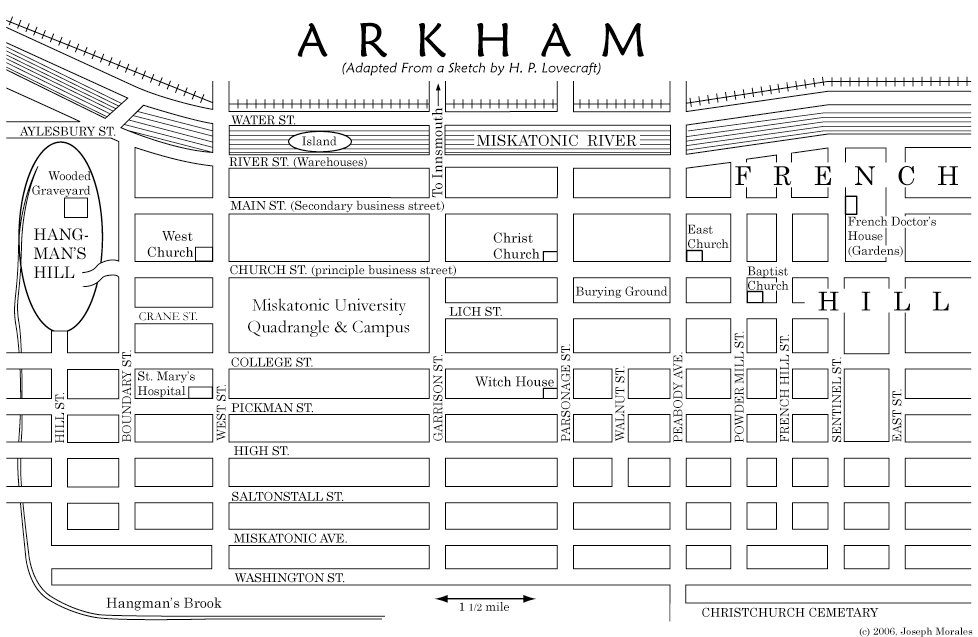
What lay behind our joint love of shadows and marvels was, no doubt, the ancient, mouldering, and subtly fearsome town in which we live—witch-cursed, legend-haunted Arkham, whose huddled, sagging gambrel roofs and crumbling Georgian balustrades brood out the centuries beside the darkly muttering Miskatonic.
—The Thing on the Doorstep
The H. P. Lovecraft Collection of Brown University Library in Providence, R.I. includes a manuscript item that must rank as one of the Holy Grails for the Lovecraft fan: HPL's own hand-drawn "Map of the Principal Parts of Arkham, Massachusetts" (Box: 24, accession no: A54798 [45]). The description in Brown's catalog reads as follows:
Drawn by HPL in early 1934. HPL to DW, 1934 Mar 28: "One thing I did lately was to construct a Map of Arkham, so that allusions in any future tale I may write may be consistent." First published as "Map of Arkham" in The Acolyte, 1, No. 1 (Fall 1942) 26.
I believe, but have not been able to verify, that this map was also printed in one of the early Arkham House omnibus volumes, possibly Marginalia, which is now fantastically rare. Fortunately, Brown University reprinted a small image of it more recently in the Lovecraft issue of Books at Brown (Volumes XXXVIII-XXXIX). That volume is also rather obscure, but through the magic of interlibrary loan and payment of a $15 fee, the vaults of Brown recently opened so far as to issue forth a photocopy of the page in question. Since most of HPL's original works are now public domain, I am hopefully transgressing no major statutes or ordinances by providing the enlarged version below:

Because HPL's handwriting and draftsmanship were both a bit sketchy, I've constructed the following adaptation which includes only the features from the original, but hopefully in a more legible form:

Thanks to Stephen Hilderbrand for sending me a correction that has been incorporated into the above: what I originally read as "Bay Front Church" seems really to be "Baptist Church." Stephen also suggests that "if you look closely at 'Lich St,' it may read 'Ligh St,' which might be missing a T, but intended to be Light St. Many old towns have a Light St. right off of Main St, so this conjecture is not too far off-base. The clue there is the tip of the g in the block to the south of where 'Lich St' is written."
On the other hand, M.T. Kuszek has written to point out that "lich is an obscure word that pertains to the dead, i.e. lich wall—the outer wall of a burial ground, or lich gate—the entrance gate to a burial ground through which the corpse passes on the way to the final place of rest. Even a wake was once called a lich wake. Basically, Lovecraft's initial intent was to use lich instead of light." Note that on HPL's Arkham map, Lich St. runs alongside a burying ground from Parsonage St. to Peabody Ave. There is at least one Old World precedent for Lich as a street name; the city of Worcester in the U.K. had a Lich St. running to the cathedral cemetery gate until 1965.
Thanks to Chris Olson for suggesting corrections to the course of Parsonage St. and French Hill St.
Another redrawn, but mostly faithful version of Lovecraft's map appeared in Philip Shreffler's The H. P. Lovecraft Companion (Greenwood Press, 1977).
If you've looked at other maps of Arkham, the above rendition might seem rather incomplete. For example, maps provided for use with role-playing games may reflect additions by later authors. There is also a really charming Arkham map by Gahan Wilson, published in The Arkham Collector for Summer, 1970. Wilson's version includes much detail of the area north of the Miskatonic, not covered by HPL's own map. I've no idea what additional sources Wilson may have consulted when preparing this map, but it is certainly plausible as well as attractive. Apparently Wilson's map has helped inspire some of the maps for role-playing games.
Differences in later versions are not necessarily "wrong." The whole Mythos has continued to evolve through the work of many writers. The above map can be seen as a starting point based in Lovecraft's original conceptions.
More information about Arkham
Return to Cthulhu Mythos: A Guide
Send comments to jfm.baharna@gmail.com.
© Copyright 1996-2021 by Joseph Morales.